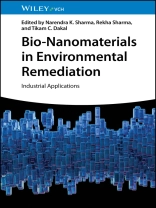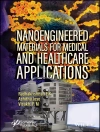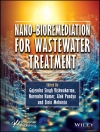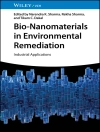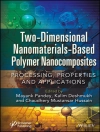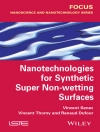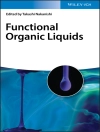Reference on using bio-nanomaterials to remove pollution in industrial sectors ranging from food and agriculture to oil and gas
Bio-Nanomaterials in Environmental Remediation discusses the application of bio-nanomaterials in various industrial settings.
Bio-Nanomaterials in Environmental Remediation includes information on:
- Fundamentals, classification, and applications of bio-nanomaterials, technologies for the fabrication of bio-nanomaterials, and desalination of wastewater using bio-nanomaterials
- Applications of bio-nanomaterials in the textiles, oil, gas, food, and agriculture industries
- Hazard, toxicity, and monitoring standards of bio-nanomaterials
- Current challenges of bio-nanomaterials in industrial applications and future outlooks in the field
- Strategies to manage the safety of bio-nanomaterials to enable the creation of healthy and pollution-free environments
Bio-Nanomaterials in Environmental Remediation is an essential up-to-date reference for professionals, researchers, and scientists working in fields where bio-nanomaterials are used.
Inhaltsverzeichnis
Brief Biography of Editors xvii
Preface xix
1 Bio-nanomaterials: An Introduction 1
Abhinoy Kishore, Chaitanayajit Singh, and Gurpreet Kaur
1.1 Introduction 1
1.2 Types of Bio-nanomaterials 3
1.3 Integration of Nanoparticles and Biomolecules 8
1.4 Application of Bio-nanomaterials 16
1.5 Advantages of Bio-nanomaterials 28
1.6 Current Challenges and Future Prospects 30
1.7 Future Perspectives 31
1.8 Conclusion 32
References 33
2 Classification and Applications of Bio-nanomaterials 47
Tikam Chand Dakal, Ravi Bhushan, Ramgopal Dhakar, and Abhishek Kumar
2.1 Introduction 47
2.2 Etymology of Nanotechnology 48
2.3 Why Bio-nanomaterials Are Required? 48
2.4 Categories of Bio-nanomaterials 49
2.5 Classification of Bio-nanomaterials 50
2.6 Application of Bio-nanomaterials 58
2.7 Toxicity of NPs and Nanomaterials 66
2.8 Conclusion 67
References 68
3 Technologies for the Fabrication of Bio-nanomaterials 75
Máaruf Abdulmumin Muhammad, Mustapha Sulaiman, Sapna Raghav, and Jyoti Raghav
3.1 Introduction 75
3.2 Bio-nanomaterial Types 77
3.4 Microorganisms as Instruments for Nanofabrication 87
3.5 Synthesis Mediated by Plants 92
3.6 Production of Bio-nanomaterials via Enzymatic Process 92
3.7 Cellular Nanotechnology 93
3.8 Peptide Self-assembly 93
3.9 Liposome Technology 94
3.10 Bio-nanomaterial Applications 94
3.11 Issues and Prospects for the Future 95
3.12 Conclusion 97
References 98
4 Desalination of Wastewater Using Bio-nanomaterials 105
Sweksha Singh, Kaushiki Gupta, Manya Sharma, Harmeet Kaur, and Narendra Kumar Sharma
4.1 Introduction 105
4.2 Desalination Tactics 106
4.3 Cursory Analysis of Traditional Desalination Techniques 107
4.4 Limitations of Traditional Desalination Methods 109
4.5 Emergence of Bio-nanomaterials 109
4.6 Miscellaneous Use of Nano-biomaterials 113
4.7 Properties of Bio-nanomaterials and Their Role in Desalination 116
4.8 Bio-nanomaterials for Wastewater Desalination 117
4.9 CNT Membranes for the Removal of Salt 121
4.10 Carbon Nanotube-Based Purification 123
4.11 Mechanisms and Influence Factors for Desalination 124
4.12 The Properties of Carbon Nanotubes Impacting Water Flow Rate 125
4.13 Environmental Impact and Sustainability 126
4.14 Future Aspects 127
4.15 Conclusion 128
References 129
5 Industrial Applications of Bio-nanomaterials in Textiles 133
Chetan Kumar, Shivam Pandey, Gaurav Uniyal, and Ritu Painuli
5.1 Introduction 133
5.2 General Processes in the Textile Industry 134
5.3 Conventional Textile Fibers 135
5.4 Biomaterials for the Textile Industry 135
5.5 Conclusion 145
References 146
6 Industrial Application of Bio-nanomaterials in Oil Industry 153
Kaustubh Chandrakant Khaire and Poornima Pandey
6.1 Introduction 153
6.2 Characterization of Bio-nanomaterials 153
6.3 Nanomaterials for Oil and Petrochemical Industries 157
6.4 Separation Techniques 160
6.5 Nanomaterials for the Oil and Gas Industry 160
6.6 Upstream Process 160
6.7 Role of Bio-nanomaterials in Oil Recovery 165
6.8 Catalytic Properties 166
6.9 Conclusions and Future Prospectus 166
References 167
7 Applications of Nanotechnology and Nanomaterials in Gas Industry 173
Tikam Chand Dakal, Ramgopal Dhakar, Ravi Bhushan, and Abhishek Kumar
7.1 Introduction 173
7.2 Why Nanotechnology in Gas Industries? 176
7.3 Applications of Different Nanomaterials 177
7.4 Different Types of Nanomaterials Used in Gas Industries 180
7.5 Challenges of Nanomaterials Used in Gas Industries 183
7.6 Future Prospects of Nanotechnology and Nanomaterials in Gas Industries 185
7.7 Conclusion 185
References 188
8 Industrial Application of Bio-nanomaterial in Food Industry 191
Priya Chaudhary and Pracheta Janmeda
8.1 Introduction 191
8.2 Nanomaterials in Food Packaging 192
8.3 Carbon Nanomaterials 193
8.4 Silicon Nanomaterials 194
8.5 Metallic Nanomaterials 195
8.6 Nanocomposites 196
8.7 Bio-nanocomposites 196
8.8 Natural Polymers 197
8.9 Biodegradable Synthetic Polymers 203
8.10 Mechanisms of Antibacterial Action 207
8.11 Nanobiosensor in the Food Industry 208
8.12 Incorporation Techniques 211
8.13 Nanotechnology in Food industry 212
8.14 Environmental and Safety Issues with Food Packaging Using Bio-nanotechnology 214
8.15 Conclusion and Future Perspectives 215
References 216
9 Industrial Application of Bio-nanomaterials in Agriculture 225
Varsha Pandey, Arpita Sharma, Deepak Kumar, Nitesh Samadhiya, and Shiv Singh Tomar
9.1 Introduction 225
9.2 Fundamentals of Bio-nanomaterials 226
9.3 Source of Bio-nanomaterials 228
9.4 Difference Between Nanomaterials and Bio-nanomaterials 230
9.5 Utilization of Bio-nanomaterials in Agriculture 231
9.6 Future of Industrial Bio-nanomaterials 240
9.7 Toxic Effects of Bio-nanomaterials in Agriculture 242
9.8 Challenges and Opportunities in Commercializing Bio-nanomaterials in Agriculture 245
9.9 Case Studies 247
9.10 Guidelines and Regulation for Evaluation of Nano-Agri input Products and Nano-Agriproducts 249
9.11 Conclusion 251
References 251
10 Bio-nanomaterials: Hazard, Toxicity, and Monitoring Standards 255
P.C. Sreeja, K. Ramesh Chandran, Rekha Sharma, and Sapna Nehra
10.1 Introduction 255
10.2 Hazards Associated with Bio-nanomaterials 256
10.3 Toxicity of Bio-nanomaterials 256
10.4 Factors Affecting the Toxicity 258
10.5 Toxicological Evaluation of Bio-nanomaterials 261
10.6 Regulatory Aspect 266
10.7 Conclusion 266
References 267
11 Challenges and Fate of Bio-nanomaterials in Industrial Applications 273
Yogendra Bhaskar, Isha Goel, Vipin Ranga, and Chandan Kumar Singh
11.1 Introduction 273
11.2 Challenges of Bio-nanomaterials in Wastewater Management 274
11.3 Challenges of Bio-nanomaterials in Textile Industries 277
11.4 Challenges of Bio-nanomaterials in Oil Industries 279
11.5 Challenges of Bio-nanomaterials in Gas Industries 283
11.6 Challenges of Bio-nanomaterials in Food Industries 285
11.7 Challenges of Bio-nanomaterials in Agriculture 287
References 288
12 Future Aspects in the Field of Bio-nanomaterials Toward Environmental Assessment 295
Anusha Srinivas, K. Ramesh Chandran, Sapna Nehra, and Dinesh Kumar
12.1 Introduction 295
12.2 Evolution of Bio-nanomaterials 298
12.3 Current State of Bio-nanomaterials in Environmental Assessment 302
12.4 Future Prospects and Innovations 306
12.5 Regulatory Frameworks and Safety Guidelines 308
12.6 Interdisciplinary Collaboration and Research Directions 308
12.7 Conclusion 311
References 312
Index 319
Über den Autor
Dr. Narendra K. Sharma, Ph D, is an Assistant Professor in the Department of Bioscience and Biotechnology at Banasthali Vidyapith, India. He has more than eight years of teaching and research experience.
Dr. Rekha Sharma, Ph D, is an Assistant Professor in the Department of Chemistry at Banasthali Vidyapith. Her specialization is in the development of water purification technologies.
Dr. Tikam C. Dakal, Ph D, is an Assistant Professor at Department of Biotechnology, Mohanlal Sukhadia University (Rajasthan), India.
